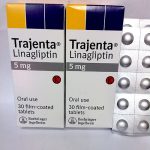Tradjenta Mechanism of Action (MOA)

Tradjenta is a brand of Linagliptin, a medication used along with diet and exercise and sometimes with other medications to lower blood sugar levels in patients with type 2 diabetes (condition in which blood sugar is too high because the body does not produce or use insulin normally). Tradjenta is not used to treat type 1 diabetes (condition in which the body does not produce insulin and, therefore, cannot control the amount of sugar in the blood) or diabetic ketoacidosis (a serious condition that may develop if high blood sugar is not treated). Tradjenta used in combination with insulin to treat diabetes has not been studied to date.
Over time, people who have diabetes and high blood sugar can develop serious or life-threatening complications, including heart disease, stroke, kidney problems, nerve damage, and eye problems. Taking medication(s), making lifestyle changes (e.g., diet, exercise, quitting smoking), and regularly checking your blood sugar may help to manage your diabetes and improve your health. This therapy may also decrease your chances of having a heart attack, stroke, or other diabetes-related complications such as kidney failure, nerve damage (numb, cold legs or feet; decreased sexual ability in men and women), eye problems, including changes or loss of vision, or gum disease. Your doctor and other healthcare providers will talk to you about the best way to manage your diabetes.
How Tradjenta works
Tradjenta (linagliptin) belongs to a class of medications known as dipeptidyl peptidase-4 (DPP-4) inhibitors.
When we eat food, our bodies break down carbohydrates into glucose, which enters the bloodstream. In response to this rise in blood glucose levels, the pancreas releases a hormone called insulin, which helps to move glucose from the bloodstream into cells where it can be used for energy.
In people with type 2 diabetes, the body becomes resistant to insulin or does not produce enough insulin to adequately regulate blood sugar levels. This leads to high levels of glucose in the bloodstream, which can cause damage to various organs and tissues in the body over time.
Tradjenta works by inhibiting the DPP-4 enzyme, which is responsible for breaking down incretin hormones in the body. Incretin hormones are released by the intestines in response to food intake and help to stimulate the pancreas to release insulin in a glucose-dependent manner. By inhibiting the DPP-4 enzyme, Tradjenta increases the levels of incretin hormones in the body, which leads to increased insulin release and decreased glucagon secretion (a hormone that raises blood sugar levels). This results in lower blood sugar levels and improved glycemic control in people with type 2 diabetes.
Tradjenta has a long half-life, which means it can remain active in the body for up to 24 hours. It is taken orally once a day, usually with or without food. It is important to take Tradjenta as prescribed and to follow a healthy diet and exercise plan to achieve the best results. Your healthcare provider can provide more information on how Tradjenta works and how to take it properly.
How to use Linagliptin Tablet
Read the Medication Guide and, if available, the Patient Information Leaflet provided by your pharmacist before you start taking Tradjenta and each time you get a refill. If you have any questions, ask your doctor or pharmacist.
Take Tradjenta by mouth with or without food as directed by your doctor, usually once daily. The dosage is based on your medical condition, response to treatment, and other medications you may be taking.
Take this medication regularly to get the most benefit from it. To help you remember, take it at the same time each day. Carefully follow the medication treatment plan, meal plan, and exercise program your doctor has recommended.
Check your blood sugar regularly as directed by your doctor. Keep track of the results, and share them with your doctor. Tell your doctor if your blood sugar measurements are too high or too low. Your dosage/treatment may need to be changed.
What are the side effects of Tradjenta?
This medication may cause changes in your blood sugar. You should know the symptoms of low and high blood sugar and what to do if you have these symptoms.
Linagliptin may cause side effects. Tell your doctor if any of these symptoms are severe or do not go away:
• headache
• joint pain
Some side effects can be serious. If you experience any of these symptoms, stop taking linagliptin and call your doctor immediately or get emergency medical treatment:
• rash
• itching, flaking, or peeling of the skin
• hives
• swelling of the face, lips, tongue, or throat
• difficulty breathing or swallowing
• hoarseness
• ongoing pain that begins in the upper left or middle of the stomach but may spread to the back
• nausea
• vomiting
• loss of appetite.
Linagliptin may cause other side effects. Call your doctor if you have any unusual problems while taking this medication.
If you experience a serious side effect, you or your doctor may send a report to the Food and Drug Administration’s (FDA) MedWatch Adverse Event Reporting program online (http://www.fda.gov/Safety/MedWatch) or by phone (1-800-332-1088).





